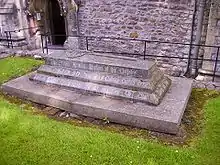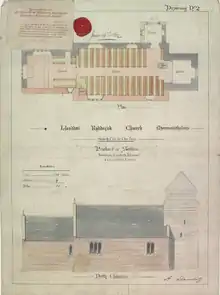John Prichard | |
|---|---|
 The grave of John Prichard in Llandaff Cathedral churchyard | |
| Born | 6 May 1817 Llangan, Glamorgan, Wales |
| Died | 13 October 1886 (aged 69) Cardiff, Wales |
John Prichard (6 May 1817 – 13 October 1886) was a Welsh architect in the neo-Gothic style.[1] As diocesan architect of Llandaff, he was involved in the building or restoration of many churches in south Wales.
Personal history
John Prichard was born in Llangan, near Cowbridge, Wales on 6 May 1817, the twelfth son of the rector Richard Prichard, who served as vicar-choral of Llandaff for 35 years.[2] He was descended from the Prichard family of Collenna.[3] John Prichard trained as an architect under Thomas Larkins Walker, and as a result was deeply influenced by the ideas of Augustus Pugin; much of his work was in a neo-Gothic style.[4]
He established a practice in Llandaff, Cardiff, becoming 'Resident Diocesan Architect' in December 1844.[5][6] Between 1852 and 1863 he was in partnership with John Pollard Seddon. Many of his major commissions were restoration works, most famously for Llandaff Cathedral (1843–69); Prichard and Seddon worked on the cathedral from the 1840s until 1869, when the south-western tower was completed (to Prichard's own design).[7] Much of their work was destroyed by enemy bombing during the Second World War.[8]
Prichard died, unmarried and childless, at the age of 69, and is buried on the south side of the cathedral.[9] On Prichard's death, Seddon succeeded him as diocesan architect.[10]
Notable projects
The Prichard Bridge, named after the architect, was built in about 1880 to allow carriages to cross the feeder channel between the River Taff and the Llandaff corn mill.[11] It is a Grade II listed building. The mill was demolished in about 1932 and the stream no longer exists; the lower part of the bridge is buried and no longer visible.[12]
One of the few secular buildings on which Prichard & Seddon worked was Ettington Park, where Prichard's brother Richard was vicar.[13] Prichard also designed Nazareth House, Cardiff, a Catholic almshouse built on land donated by John Crichton-Stuart, 3rd Marquess of Bute. The chapel of the latter was not Prichard's work; it was added later.[14]
Buildings

- Llandaff Cathedral, Llandaff (1843–1869) restoration.[9]
- Church of St Swithin, Ganarew (1850)[15]
- St Michael's Church, Cwmafan (1851).[16]
- Church of the Holy Cross, Cowbridge (1850–1852) restoration.[17]
- The Church of St Julius and Aaron, Llanharan (1856–1859) restoration.[18][19]
- St Mary's Church, Aberavon rebuilding[20]
- Ettington Park, near Stratford upon Avon (1858–1862) restoration.[13]
- Church of St John, Llandenny (1860-5) with John Pollard Seddon
- Church of St David, Llanddewi Rhydderch, Monmouthshire (1862–1863) restoration[21]
- St Mary's on Chapel Hill, Tintern, Monmouthshire (1863–1868) restoration[22]
- St Margaret's Church, Roath (1870) commissioned by the Marquess of Bute[23]
- St Crallo, Coychurch (1871) restoration[24]
- St Michael and All Angels, Mitchel Troy (1873-1876) rebuilding commissioned by the 8th Duke of Beaufort
- Church of SS. Illtyd, Gwynno & Tyfodwg, Llantrisant (1874) restoration[25]
- Nazareth House, Cardiff (1875)
- St Catharine's Church, Baglan (1875–1882) restoration[26]
- Church of St Thomas a Becket, Monmouth (1876)[27]
- St Cadfan's Church, Tywyn (1877) restoration.[28]
- Racquets and Fives Club (now Jackson Hall), Cardiff (1878)[29]
- Prichard Bridge, Llandaff (c.1880)[30]
- St Mary's Church, Whitchurch, Cardiff (1884)
- St Mary's Nolton, Bridgend (completed 1877) build[31]
- Elerch Vicarage
References
- ↑ The Welsh Academy Encyclopaedia of Wales. John Davies, Nigel Jenkins, Menna Baines and Peredur Lynch (2008) p.710. ISBN 978-0-7083-1953-6
- ↑ Ellis, Megan. "John Prichard". Dictionary of Welsh Biography. National Library of Wales. Retrieved 20 April 2016.
- ↑ "Prichard family of Collenna, Llantrisant,papers". Glamorgan Archives. National Library of Wales. Retrieved 20 April 2016.
- ↑ "John Prichard (1818-1886)". Stained Glass in Wales. University of Wales. Retrieved 21 April 2016.
- ↑ Monmouthshire Beacon, 21 December 1844, p. 3.
- ↑ John Newman (2000). The Buildings of Wales: Gwent/Monmouthshire. Yale University Press. p. 56. ISBN 9780300096309.
- ↑ The Architect and Building News. 1873. pp. 118–.
- ↑ John Newman; Stephen R. Hughes; Anthony Ward (1995). The Buildings of Wales: Glamorgan (Mid Glamorgan, South Glamorgan and West Glamorgan). Yale University Press. p. 92. ISBN 9780140710564.
- 1 2 "History". Llandaff Cathedral. Retrieved 20 April 2016.
- ↑ The Red Dragon: The National Magazine of Wales. Daniel Owen, Howell and Company. 1886.
- ↑ "Prichard Bridge". People's Collection Wales. Retrieved 20 April 2016.
- ↑ "Bridge to north extension of Graveyard of Cathedral of Ss Peter and Paul, Llandaff". British Listed Buildings. Retrieved 20 April 2016.
- 1 2 Geoffrey Tyack (1 January 1994). Warwickshire Country Houses. Phillimore. ISBN 978-0-85033-868-3.
- ↑ John Newman; Stephen R. Hughes; Anthony Ward (1995). Glamorgan: (Mid Glamorgan, South Glamorgan and West Glamorgan). Penguin Books; University of Wales Press. pp. 285–. ISBN 978-0-14-071056-4.
- ↑ Royal Commission on Historical Monuments (England); Crawford, David Lindsay (1934). An inventory of the historical monuments in Herefordshire. H. M. Stationery off., printed by William Clowes & sons, ltd. p. 96. Retrieved 25 March 2012.
Parish Church of St. Swithin, was entirely rebuilt in 1850...
- ↑ The Welsh Academy Encyclopaedia of Wales p.181
- ↑ The Welsh Academy Encyclopaedia of Wales p.174
- ↑ "Church of SS Julius and Aaron, Llanharan". British Listed Buildings. Retrieved 21 April 2016.
- ↑ The Welsh Academy Encyclopaedia of Wales p.500
- ↑ "Church of St Mary". British Listed Buildings. Retrieved 12 May 2018.
- ↑ Cadw. "Church of St. David (17417)". National Historic Assets of Wales. Retrieved 11 April 2019.
- ↑ "Former Church of St Mary, Tintern". British Listed Buildings. Retrieved 20 April 2016.
- ↑ Childs, Jeff (2012). Roath, Splott and Adamsdown: One Thousand Years of History. History Press. ISBN 9780752482576.
- ↑ Newman (1995) p.334
- ↑ The Welsh Academy Encyclopaedia of Wales p.507
- ↑ The Welsh Academy Encyclopaedia of Wales p.46
- ↑ "Church of St Thomas, Monmouth, Monmouthshire". Stained Glass in Wales. llgc.org.uk.
- ↑ Meryl Gover (28 April 2015). Cadfan's Church: A History with Digressions. Troubador Publishing Ltd. pp. 147–. ISBN 978-1-78462-290-9.
- ↑ Hignell, Andrew (2017). Always Amongst Friends: The Cardiff and County Clubb 1866-2016. Cardiff: Welsh Academic Press. ISBN 978-1-86-057129-9.
- ↑ Cadw. "Bridge to north extension of Graveyard of Cathedral of Ss Peter and Paul (81257)". National Historic Assets of Wales. Retrieved 11 April 2019.
- ↑ The Welsh Academy Encyclopaedia of Wales p.83
Bibliography
- Davies, John; Jenkins, Nigel; Menna, Baines; Lynch, Peredur I., eds. (2008). The Welsh Academy Encyclopaedia of Wales. Cardiff: University of Wales Press. ISBN 978-0-7083-1953-6.
- Newman, John (1995). Glamorgan. London: Penguin Group. ISBN 0140710566.